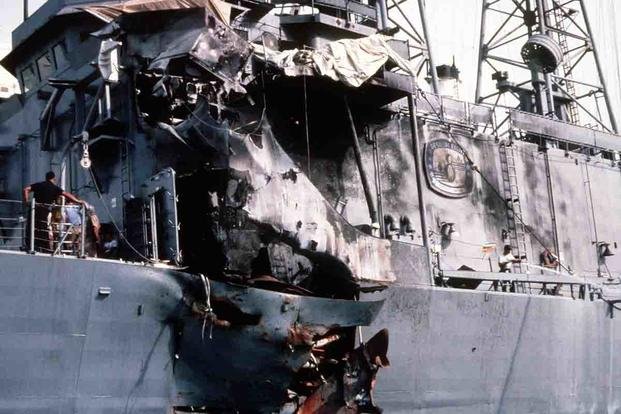Although first produced in 1967, the French-made Exocet anti-ship missile has a deadly service history. The weapon uses active radar to home in on its target, skims the ocean surface as it approaches its target and hits with a high-explosive, semi-armor piercing warhead at just below the speed of sound.
It’s also a versatile weapon and civilian jets can be modified to fire the Exocet missile, as the U.S. Navy uncovered after the USS Stark was hit by two of them in the Persian Gulf in 1987.
Flying in at high speeds, just 6.5 feet above the water, the Exocet missile is a very hard weapon to see and even more difficult to defend against. So when an Iraqi aircraft fired two Exocet missiles at the USS Stark in 1987, the American guided missile frigate was lucky to survive. U.S. sailors weren't so lucky.
Exocet missiles didn't see combat until the United Kingdom went to war with Argentina over the Falkland Islands in 1982. The Royal Navy's chief concern was Argentina's Exocet missile stockpile.
The bulk of British naval losses came at the hands of Argentine Exocet missiles, sinking the guided missile destroyer HMS Sheffield and the supply ship MV Atlantic Conveyor. Exocets also damaged other British ships and killed dozens of sailors.
The USS Stark was in the Persian Gulf to protect oil tankers traversing through the area from being attacked by Iranian forces. At the time, Iran and Iraq had been at war for seven years in a brutal stalemate that killed an estimated half-million people on both sides.
Although officially neutral in the conflict, the United States provided significant materiel support to Iraq, as well as protection for international shipping in the Persian Gulf region and through the Strait of Hormuz. The USS Stark was part of that mission. Nearly a dozen tankers and merchant vessels had been sunk in the region since the start of the Iran-Iraq War, all by Exocet missiles.
On May 17, 1987, Stark was off the coast of Saudi Arabia, outside the Iran-Iraq War's exclusion zone at just after 10 p.m. local time when it picked up an incoming aircraft. Originally believed to be a Dassault Mirage F1 fighter, Stark requested it to identify itself when it turned toward the ship. No reply came. No reply came for the ship's second request, either.
In less than 10 minutes after first detecting the incoming craft, the ship was targeted by the jet's radar. It fired two Exocet missiles and then withdrew. The Stark didn't detect either of the incoming missiles until they were 1.5 minutes away. Stark's air defenses did not activate in time, and both hit the ship on its port side.
The first missile warhead failed to detonate but penetrated the hull. Fuel from the missile caught fire and spread through the ship's interior, including its weapons control systems. The ship was unable to defend itself. Thirty seconds later, the second missile hit Stark and exploded, ripping a 15-foot-wide hole in the port side.

Thirty-seven sailors were killed or lost at sea in the attack. Another 21 were wounded but survived. Stark never fired a weapon in defense or in retaliation, and the Iraqi fighter escaped the area unharmed. The Stark began to list after the attack, and the ship's captain, Capt. Glenn Brindel, ordered the starboard side of the vessel flooded to keep it level and prevent it from sinking.
The U.S. Navy's board of inquiry determined that the attack could not have come from a Mirage F1 fighter, as that aircraft could only fire one Exocet missile. It was actually from a Dassault Falcon 50 business jet, modified to fire Exocet missiles.
In the aftermath of the attack, Capt. Brindel was reprimanded and relieved of duty. He opted to retire early, but since he had not held the rank of captain long enough, he was forced to retire as a commander.
Iran called the incident a "divine blessing" and warned the West to stay out of the Persian Gulf. Iraq, controlled by Saddam Hussein's Ba'athist regime at the time, apologized for the attack and agreed to pay $27.3 million in compensation to the families of the 37 US Navy personnel killed.
President Ronald Reagan did not take Iran's warning. Instead, he recommitted the U.S. to protecting international shipping in the area and maintained the U.S. Navy presence. The USS Stark was escorted to Bahrain for repairs before returning to port in Florida. It returned to the Middle East in the 1990s before being decommissioned in 1997.
-- Blake Stilwell can be reached at blake.stilwell@military.com. He can also be found on Twitter @blakestilwell or on Facebook.
Want to Learn More About Military Life?
Whether you're thinking of joining the military, looking for post-military careers or keeping up with military life and benefits, Military.com has you covered. Subscribe to Military.com to have military news, updates and resources delivered directly to your inbox.
















